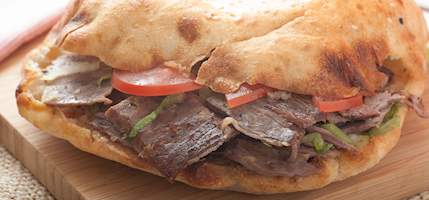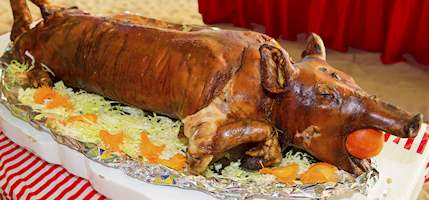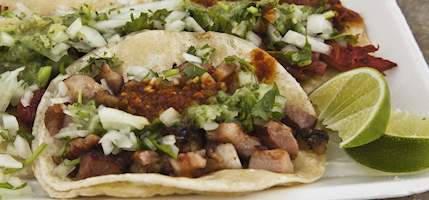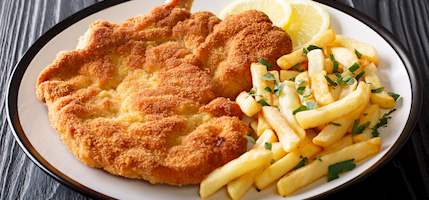Imbuljuta tal-Qastan
Imbuljuta tal-Qastan is a traditional Maltese drink made with chestnuts, cocoa, sugar, tangerine rind, mixed spices, and cloves. Traditionally, it is served piping hot in mugs or small bowls after the midnight mass and on New Year’s Eve. The chestnuts are soaked overnight, drained, rinsed, and then placed back into the saucepan with enough liquid to cover them completely. The rest of the ingredients are then added and brought to a boil. The drink is ready when the chestnuts are soft and tender.
Ġulepp tal-ħarrub
Ġulepp tal-ħarrub is a syrup made from pods of the carob bush, a species of flowering evergreen shrub that is widely used in cooking, often as a replacement for cocoa. In Malta, it's used as a traditional medicine to treat coughing and sore throat. Apart from its medicinal properties, it can also be used as a sweetener and is considered a natural source of iron, phosphorus, natural fibers, and calcium.
Għadam tal-mejtin
Għadam tal-mejtin are traditional bone-shaped Maltese cookies. They consist of a shortcrust biscuit base and an almond filling. The cookies are traditionally prepared and enjoyed for All Souls day. The dough is usually made with a combination of flour, butter, sugar, egg yolks, lemon zest, and vanilla. The filling is made with a combination of ground almonds, icing sugar, and egg whites. Once filled, the cookies are baked in the oven until golden, then topped with icing consisting of icing sugar, water, and almond extract. If stored in a cool and dry place, these bone-shaped cookies can keep for up to a month.
Sfineġ
Sfineġ is a traditional Maltese fritter made with a combination of flour, yeast, salt, warm water, oil, and (optionally) anchovies. When the dough becomes soft, it is left to rest, and it's then combined with anchovies. The fritters are fried in hot oil until golden brown and ready to be eaten. These small fritters are typically prepared and enjoyed during Lent, when meat is forbidden. Nowadays, there are many versions of sfineġ, both sweet and savory.
Klamari mimlija
Klamari mimlija is a traditional dish originating from Malta. The dish consists of stuffed squid. Although every chef has his own recipe, the squid is most commonly stuffed with a combination of onions, garlic, breadcrumbs, ricotta, chopped tentacles, Kalamata olives, parsley, oregano, lemon juice, and olive oil. Once stuffed, the squids are sealed with toothpicks, then baked in the oven until slightly golden on top. The squid is sliced and served warm with tomato sauce and lemon wedges on the side.
Falda mimlija
Falda mimlija is a traditional Maltese dish consisting of stuffed flank steak. The flank is cut open and usually stuffed with a combination of ground pork, chopped bacon, breadcrumbs, onions, eggs, grated cheese, salt, and pepper. Once stuffed, the flank is tied with twine, then slowly simmered with chopped vegetables such as potatoes, carrots, celery, turnip, and onions. After a few hours, the flank is served topped with the vegetable sauce and accompanied by mashed or roasted potatoes on the side.
Bebbux mimli
Bebbux mimli is a traditional pasta dish originating from Malta. The dish is usually made with a combination of lumache (snail-shaped pasta), semolina, ricotta, grated cheese, nutmeg, parsley, eggs, tomato sauce, salt, and pepper. The ricotta is mixed with the eggs, grated cheese, nutmeg, seasonings, and parsley. The pasta is stuffed with the mixture and the open ends are then dipped in semolina so that the lumaconi remain intact while they're cooking. Once the stuffed pasta rises to the top, it's cooked. The stuffed lumaconi are served in warm tomato sauce, toped with grated cheese and a pinch of freshly ground black pepper.
Torta tal-lampuki
Torta tal-lampuki is a traditional Maltese pie made with lampuki as the key ingredient. Also known as dolphinfish or small dorado, lampuki swims in Maltese waters from August until November. When used in torta tal-lampuki, it is combined with olives, spinach, and any other ingredients that can be found in a typical Maltese kitchen – be it onions, tomatoes, capers, or mint. Due to the abundance of local recipes, no torta tal-lampuki pie is the same. The pie is baked until golden brown, and it is recommended to serve it lukewarm, as it may crumble if served straight out of the oven.
Torta tal-irkotta
Torta tal-irkotta is a Maltese pie consisting of a puff pastry or shortcrust pastry base that is filled with a combination of ricotta, goat's cheese, beaten eggs, cream, chopped parsley, and either broad beans or peas. The pie is a favorite with many Maltese people, and it is typically baked until it develops a golden-brown color on the exterior. It is then sliced and (ideally) served with a fresh salad on the side.
Brunġiel mimli
Brunġiel mimli is a traditional dish originating from Malta. The dish consists of stuffed and baked eggplants. The eggplants are washed, cut in half, and boiled. The flesh is removed with a spoon and set aside for later. The eggplants are stuffed with a combination of ground meat (pork, beef, or both), eggs, onions, tomato paste, salt, pepper, grated cheese, and the previously removed eggplant pulp. Once stuffed, they're arranged in a baking dish and baked in the oven for about half an hour, then served.
Qaqoċċ mimli
Qaqoċċ mimli is a traditional dish hailing from Malta. The dish consists of stuffed artichokes. The artichokes are usually stuffed with a combination of crumbled sourdough bread, anchovy fillets, parsley, garlic, olive oil, salt, and pepper. If desired, chopped Kalamata olives can also be added to the stuffing, which is gently pushed in the spaces between the artichoke leaves and in the space where the heart is located. Once stuffed, the artichokes are steamed or simmered in water for about half an hour until tender, and they are then drizzled with olive oil and served immediately.
Laħam taż-żiemel
In Malta, horse meat is regarded as a local delicacy that is occasionally found on the menus of traditional restaurants. The meat is usually prepared as a stew that is marinated and then slowly cooked in a red-wine sauce, typically alongside onions, tomatoes, and various herbs and spices. Horse meat stew is usually paired with roasted potatoes or crusty sourdough bread on the side.
Xiang gan
Xiang gan is a type of dried Chinese tofu, known for its firm texture and ability to absorb flavors well, making it a popular ingredient in various dishes. It is made by pressing a block of firm or extra-firm tofu to remove excess moisture, then baking or frying it until it's thoroughly dried and has a chewy texture. Optionally, it can be marinated in a mixture of soy sauce, five-spice powder, and sesame oil before drying to enhance its flavor. This ingredient is appreciated for its versatility and nutritional benefits, including being a good source of protein for vegetarian and vegan diets.
Session IPA
A Session IPA (India Pale Ale) is a style of beer that merges the hoppy characteristics of a traditional IPA with a lower alcohol content, making it more suitable for extended drinking sessions. Typically, Session IPAs have an alcohol by volume (ABV) ranging between 3% and 5%, significantly lower than the standard IPA, which often has an ABV of 6% to 7.5% or higher. Despite the reduced alcohol content, Session IPAs retain the bold hop flavors characteristic of IPAs, featuring aromatic profiles with notes of citrus, pine, floral, or tropical fruit. The malt backbone is lighter and less sweet, allowing the hops to shine while providing a crisp, refreshing finish. This combination of strong hop flavors and a lighter body results in a beer that is flavorful yet easy to drink, making it ideal for social settings or long afternoons. Session IPAs have gained popularity, especially among craft beer enthusiasts who enjoy the vibrant hop-forward flavors of IPAs but prefer a beer that is less intense and more drinkable. Many breweries now offer Session IPAs as part of their regular lineup, catering to those who seek a flavorful beer without the high alcohol content.
Qaymar
Qaymar (also spelled geymar) is a rich, creamy dairy product commonly consumed in Iraq and other parts of the Middle East. It is similar to clotted cream or kaymak found in Turkey. Qaymar is made by slowly simmering raw buffalo milk (or sometimes cow's milk) until the cream rises to the surface. The cream is then skimmed off and left to cool and thicken into a luscious, velvety layer. Qaymar is traditionally enjoyed as part of breakfast, served with honey, date syrup, or jam, and often paired with flatbread or pastries like kahi in Iraq. It is prized for its luxurious, mildly sweet flavor and smooth, rich texture, making it a favorite in Iraqi households and throughout the region.
Petit Verdot
Petit Verdot is a red wine grape variety known for its deep color, robust tannins, and rich flavors. Originating from the Bordeaux region of France, Petit Verdot is traditionally used as a blending grape in Bordeaux wines, particularly in the Médoc and Graves appellations. Due to its late ripening, it was often challenging to fully mature in Bordeaux's cooler climate, leading to its limited use. However, it has gained popularity in other wine regions with warmer climates, such as California, Australia, and South America, where it can ripen more consistently. Petit Verdot wines are characterized by their intense color and strong tannic structure. The flavor profile typically includes dark fruit notes such as blackberry, black cherry, and plum, along with complex aromas of violet, sage, and leather. As the wine ages, it can develop additional flavors of spice, chocolate, and earthy undertones. In Bordeaux, Petit Verdot is primarily used in small quantities to add color, tannins, and aromatic complexity to blends dominated by Cabernet Sauvignon, Merlot, and Cabernet Franc. Its contribution helps enhance the overall structure and aging potential of the wine. In regions outside of Bordeaux, Petit Verdot is increasingly being produced as a single-varietal wine, showcasing its unique characteristics. These wines tend to be full-bodied with high tannins and acidity, making them suitable for aging. They often require some time in the bottle to soften and develop their full range of flavors. Petit Verdot wines pair well with rich and hearty dishes due to their bold structure and intense flavors. They are an excellent match for grilled or roasted meats, such as beef, lamb, and game, as well as dishes with robust sauces and strong cheeses.
Ħelwa tat-tork
Maltese nut fudge hails from the time when the island was under Arabian rule, and over time it became an important part of local cuisine. Ħelwa tat-tork is made by dissolving tahini and sugar in water to form a dense paste which is then studded with whole roasted almonds. In Malta, this delicious nut fudge is traditionally served after lunch or dinner, and it is typically enjoyed with coffee.
Tal-majjal u patata
Tal-majjal u patata is a traditional casserole originating from Malta. The dish is usually made with a combination of pork, potatoes, onions, garlic, hot peppers, fennel seeds, olive oil, salt, and black pepper. The garlic and onions are sautéed in olive oil. The potatoes and pork are cut into cubes and added into the pan. The ingredients are well stirred, and the hot peppers, fennel seeds, salt, and pepper are then added to the mixture. Some water is added to the dish and it's baked in the oven in a casserole dish until everything is tender and fully cooked.
Bidni
Bidni is an ancient and indigenous Maltese variety of olive known for its unique genetic heritage and high-quality oil production. The name "bidni" comes from the Bidnija area in Malta, where these olives have been traditionally cultivated. The Bidni olive tree is hardy and resistant to harsh weather, pests, and diseases, making it well-suited to Malta's dry Mediterranean climate and rocky soil. The olives are small, dark, and have a distinctive, rich flavor profile. Bidni olives are primarily used for oil production, yielding extra virgin olive oil that is highly regarded for its fruity, peppery, and robust flavor with a slight bitterness. The oil is known for its exceptional quality and high levels of antioxidants. Bidni olives have been grown in Malta for centuries, with evidence suggesting they date back to ancient Roman or even earlier times. The variety is genetically unique, meaning it is found exclusively in Malta, adding to its cultural importance and making it a symbol of Maltese agricultural heritage. Today, Bidni olives are prized for their high-quality oil, which is often marketed as a premium product and celebrated for its health benefits and culinary excellence. The oil pairs beautifully with Maltese bread, salads, and seafood, and it also features in traditional recipes. Efforts are ongoing to protect and promote the Bidni variety, ensuring its preservation as a key part of Malta’s agricultural and culinary identity.
Sarma
One of the staples of traditional Turkish cuisine, sarma consists of a filling that is snugly surrounded by leaves or leafy vegetables. There are numerous versions of this dish but the mixture typically combines ingredients such as minced meat, rice or bulgur, various herbs, seasonings, red pepper, paprika, ground sumac, or tomato sauce, while the typical wrapping usually includes vine, cabbage, or sauerkraut leaves, or a variety of leafy vegetables such as collard greens and swiss chard. Having its roots in the Ottoman Empire, sarma is also traditionally consumed in the Balkans, the countries of Central Europe, the South Caucasus, and the Middle East. Although it is commonly enjoyed as a filling lunch or dinner (typically during the winter season), sarma is often prepared on special occasions and holidays. The dish is usually accompanied by plain yogurt, mashed potatoes, and crusty bread on the side.
Tombik Döner
Tombik döner or gobit kebab is a variety of döner kebab where the shredded meat is stuffed in a bun-shaped flatbread known as pide ekmek. The bread has a crispy exterior and a soft interior. This dish is typically served with additional ingredients, depending on the customer's choice, such as tomatoes, onions, lettuce, or other assorted vegetables and sauces.
Kutia
Kutia is a Ukrainian, Russian, Belarusian, and Polish sweet grain pudding that is traditionally served as part of a twelve-meal Christmas Eve supper. Interestingly enough, this festive treat is believed to have existed long before Christianity. It is made with wheat, berries, honey or sugar, nuts, raisins, and poppy seeds.On Christmas Eve, before consuming the dish, a small bowl of kutia is traditionally placed outdoors as a bribe to Father Frost, then some of the kutia is tossed to the ceiling, and the number of grains that stick to the ceiling are used to predict next year's agricultural prosperity.
Čvarci
Čvarci or ocvirki is a traditional specialty that's popular in Southeastern Europe and the Balkans. This variety of pork rinds or cracklings is usually homemade, and it's made by thermally extracting fat from the lard. The lard is usually cut into blocks and fried in its own fat until it melts away and tough and crispy pork rind remain in the pot. During the process, čvarci are constantly stirred with big spoons, and milk is often added in order for them to obtain the color of caramel. Salt is typically added to the mixture, while some cooks like to add garlic or onions to the mixture. Čvarci are typically made in late autumn or winter, often during the pig slaughter, and they're usually enjoyed as a snack, served with bread and raw onions and paired with beer or rakija on the side. Small pieces of čvarci are often used in savory snacks such as pogačica s čvarcima.
Indigirka Salad
Indigirka is a Russian fish salad that has its origins in Yakutia (Sakha). It consists of diced frozen fish that is combined with onions, oil, salt, and pepper. The salad is typically made from whitefish such as broad whitefish (also known as chir), nelma, and muksun, and it is traditionally served in ice bowls. Indigirka salad first appeared in the middle of the 20th century and was named after the Indigirka River, one of the major Yakutian rivers. It is believed it was created by chef Innokenty Tarbakhov, who based it on a similar ethnic Yakutian dish made with raw fish called raw in the Yakut language or five minutes in Russian. The salad is occasionally accompanied by lemon wedges, but modern variations may include fish roe, fennel, as well as various dressings. This well-chilled appetizer ideally pairs with vodka.
Lechon
Lechon, derived from a Spanish word for roasted suckling pig is one of the most popular dishes in the Philippines. The slowly-roasted suckling pig is usually stuffed with lemongrass, tamarind, garlic, onions, and chives, and is then roasted on a large bamboo spit over an open fire. It is traditionally served whole on a platter, at celebrations and festive events such as weddings and Christmas. Once the meat is properly roasted and falls off the bone, people tend to eat every part of the pig, and the crispy, reddish-brown, crackling skin is especially beloved. Lechon is often served with a thick and rich liver sauce that is cooked with sugar, fresh herbs, and vinegar. If anything is left after the feast, the leftovers are often made into lechon slaw, slowly cooked with vinegar, garlic, and liver sauce for that extra bit of flavor. Apart from the Philippines, the dish is especially popular in countries such as Cuba, Puerto Rico, the Dominican Republic, and Spain. Some famous chefs even named lechon the best pig in the world, so it is definitely worth a try.
Bougatsa
Bougatsa is a traditional, rustic Greek pie consisting of a phyllo pastry layered with a filling of semolina custard, although there are variations with minced meat or cheese. The name of the dish is a derivation of the Ottoman word pogatsa, denoting a pie filled with cheese. Bougatsa has origins from the Byzantine period, when Constantinople was Greek, and it began as a dough that was stuffed with numerous sweet and savory fillings. Over time, bougatsa evolved to incorporate a thinly rolled, hand-made phyllo pastry. As many Turkish immigrants settled in Northen Greece, bougatsa became a specialty of Serres and Thessaloniki. Today, the pies can be found throughout Greece in specialty shops called bougatsopolia, selling bougatsas exclusively.
Mila Zagoras Piliou
Mila Zagoras Piliou are apples obtained from the Starking Delicious variety in Zagora, Makrirahi and Pouriou on the eastern side of Pilios. The systematic cultivation of these apples started in the 1960s under the supervision of the Zagora Agricultural Cooperative. They owe their distinctive characteristics to high altitudes where they are grown, special weather conditions and the use of traditional cultivation techniques. Mila Zagoras Piliou are harvested by hand after their ripeness is checked. Following the quality assessment, they are packed and stored in the cooperative's modern installations. They can be recognized by their vivid red color and a smooth, waxy skin. Their flesh is white to yellow, very juicy and full of flavor.
Anticuchos
Anticucho is a meat dish consisting of small pieces of skewered and grilled meat, the most popular of them made with beef heart, called anticuchos de corazón. Incan in origin, the dish quickly gained popularity throughout South and Central America. The first written recipe dates back to the 16th century, referring to a meal of marinated llama meat cooked directly over a fire. When the conquistadors encountered the dish, they modified it to make it their own, replacing the llama meat with beef, which was skewered on sugar cane stalks. Today, the meat is typically marinated in red wine vinegar and spices such as garlic, cumin, and aji pepper - developing a fruity flavor when roasted. Anticucho can be found throughout Peru and has spread to other South American countris (especially popular in Bolivia) on numerous street carts and street food stalls, called anticucheras. Typical accompaniments to the dish include corn or boiled potatoes.
Hessischer Handkäse
The name and the size of Hessen Handkäse are both derived from its traditional manufacturing method, in which the cheese was molded by hand. Handkäse is a German regional sour milk cheese produced in Frankfurt Rhine-Main and Rheinhessen. It has a fat content of less than 1% and an impressive protein content of 25%. Hessen Handkäse is a delicious cheese with quite a pungent aroma, and it is usually served sprinkled with caraway seeds and topped with sliced onions. Traditionally, this cheese is served either plain or as 'Hessen Handkäse mit Musik', seasoned with salt and pepper and marinated with onions in oil and vinegar, occasionally with some water or a dash of cider or wine added to the marinade.
Spätzle
Spätzle is the German answer to pasta: thick noodles made from water, salt, flour, and eggs. They are very moist and have a soft texture, so it is not possible to roll them out – instead, they are shaped by hand, with a knife, or pressed through a variety of spätzle-presses. The raw noodles are placed in boiling water and are finished as soon as they float up to the top. The first written recipe for spätzle dates back to 1725, although it is still not known who invented them. Spätzle are used in a variety of dishes and can be combined with ingredients such as cheese, lentils, sausages, sauerkraut, butter, and spinach.
Dacquoise
Both crispy and creamy in texture, this French cake is traditionally made with almond or hazelnut meringue sponge cake separated with layers of whipped cream or buttercream. The cake takes its name from the French word dacquois, meaning from Dax, referring to a town located in southwestern France, but the term dacquoise itself has come to signify any dessert with layers of nut meringue sponge cake. The cake is believed to have originated in the 17th century, when it was invented as a luxurious dessert for the people of the French court. The recipe later became very popular in England, after numerous French chefs moved there to cook for the upper class. Its huge popularity generated a wave of different versions of the cake, such as the infamous marjolaine, a rectangular variety of dacquoise known as the mother of all French desserts, which is made with meringue sponge cake and chocolate buttercream.
Pizza
The story of the invention of this everyday household name changes depending on how you define it. If you think a pizza is an oven-baked flatbread, its origins lie in the ancient Middle East. If pizza must have toppings, its origins date back to the ancient Romans and Greeks, who baked flatbreads and topped them with available, local spices and olive oil. But the pizza we all know today, made with tomato sauce, cheese, and numerous toppings, originated in Italy. It became popular in Naples in the 18th century as a cheap, nourishing food that was consumed mainly by peasants. The modern pizza as we know it today evolved from early Neapolitan flatbreads topped with lard, salt, and garlic. No one knows when or why the tomato first began being used in the preparation of pizza, but it is known that they were first recorded in Italy in 1544. While most Europeans initially disparaged them as poisonous, the southern Italians embraced them, giving them the name pomi d’oro (golden apples). Although some say that tomatoes have been used on pizza marinara since 1734, others claim that they were not used until the early 19th century. The Italians credit Raffaele Esposito of Pizzeria Brandi as having invented the first modern pizza in 1889. He was supposed to make a variety of pizzas for the queen, so he made one with lard, cheese, and basil, one with fish, and one with mozzarella, basil, and tomatoes. Known as pizza alla mozzarella at the time, this last pizza later became known as pizza margherita, once the queen declared it as her favorite. Interestingly enough, the colors of the margherita are the same as those found on the Italian flag. Pizza crossed over the Italian border shortly thereafter, to Spain, France, England, and the United States, where it was introduced by Italian immigrants. However, it didn’t gain much popularity until after World War II. In the United States, the first pizzeria was opened in New York City by Gennaro Lombardi in 1905, and since then it has become one of the most popular food items in the United States. In an ironic twist of fate, American-style pizza has been re-exported back to Italy, where it is has also gained in popularity today. In 2008, two Italian associations called Real Pizza and the Association of Neapolitan Pizza-makers introduced new regulations on what constitutes a true Neapolitan pizza. According to them, the real, legally-protected Neapolitan margherita should be made with exact amounts of mozzarella, salt, and tomatoes, and it should be baked in a wood-fired oven at 485°C. Today, there are numerous variations of this beloved dish throughout the world, from those with simple toppings such as ham, prosciutto, onions, and bell peppers, to unusual variations such as hot dog or hamburger pizza or decadent toppings such as white truffles, edible gold, lobster, and caviar.
Chicha morada
Chicha Morada is a non-alcoholic drink originating from Peru whose use and consumption dates back to the era before the creation of the Inca empire. It is traditionally made by boiling purple corn and pineapple rinds in water, and once all the juices have gotten into the water, the combination is left to cool down. Sugar, cinnamon, and cloves can be added later for extra flavor. This simple drink can be found in street markets as well as in upscale restaurants and home kitchens throughout Peru and Bolivia.
Acarajé
In Bahia, the northeastern state of Brazil, there is a dish that is considered to be the most popular street food around, called acarajé. It consists of black-eyed peas or cowpeas that are formed into a ball, deep-fried in dendé palm oil, split in half, then stuffed with flavorful, spicy pastes made from numerous ingredients such as cashews, palm oil, and shrimp. The most common accompaniments to the dish include a tomato salad and homemade hot pepper sauces. The recipe for the dish originated during the colonial period of the country, from the Nigerian slaves who first started selling it on the streets of Brazil. Today, acarajé represents a good example of how African influences have been shaping Brazil's cultural heritage and its culinary identity.
Tacos
Tacos are the national dish of Mexico, dating back to the Mexican silver mines of the 18th century, when the word taco referred to gunpowder that was wrapped in a piece of paper and inserted into rocks. It was used to excavate the precious ore from mines and was called tacos de minero or miner's tacos. Today, the word is widely known to signify the leading street food and fast food item in Mexico – thin, flat griddle-baked tortillas topped with numerous fillings, folded and eaten without any utensils. A taco is basically anything eaten on a soft tortilla, and there is an infinite variety of them. In Sonora, in the north of Mexico, they eat the classic carne asada - thinly sliced meat grilled over coals and topped with salsa, onions, guacamole, and a lime wedge. In Baja, the topping consists of fried fish with cabbage and an acidic mayonnaise sauce. In Mexico City, sudados (sweated tacos) are the most popular option, filled with cooked and steamed meat. In Jalisco and Michoacan, they prepare carnitas, eaten in the morning or in the early afternoon, filled with deep fried pieces of pork that are sliced according to preference. Similar is the taco de cabeza, filled with pieces of cow's head that was steamed for a long time, and the customers can choose from slices of eyes, brains, tongue, lips, cheek, or ears. Tacos are mainly made of corn, except in the north, where wheat flour is used more often. They also differ in size, from the tiniest white tacos (blancas) to bigger ones, often made with blue corn. Most tacos come in pairs of two, in order to be able to hold all the flavorful and slightly wet ingredients. Some of them are fried until they become crispy and crunchy, in which case they're called tostadas. As anything can be a filling, there is a version made with fried veins from dried chiles, usually accompanied by salt, a tasty treat called tacos de venas. However, the standard is ground or shredded meat, cheese, potatoes, or vegetables and a topping of onions and coriander. Eaten at all times of day and night, one can find them on every corner in Mexico, in restaurants known as taquerias. Alternatively, they can be bought from numerous street vendors.
Coquito
Coquito is a traditional Puerto Rican cocktail similar to eggnog. It is typically prepared and consumed during the festive Christmas season. The cocktail is made with a combination of coconut milk, rum, condensed milk, and vanilla, although every family has their own variation. In order to prepare it, all ingredients should be blended, then chilled and served in small glasses. It is recommended to garnish coquito with nutmeg on top. The name of this drink means little coconut. In Cuba, they serve it with scoops of coconut ice cream, while the Spanish people serve it with turron.
Fish and chips
Most Brits would agree that there is nothing more British than fish and chips. This comforting, widely loved national dish consists of a freshly fried, hot, white fish fillet and large, sliced and fried potatoes. Cod, haddock, and flounder are the most common types of fish that is fried for the dish, and the customers can choose which type of fish they want, with cod being the most popular choice. The fillets get dipped in a batter made from eggs, milk, and flour, and are then fried in oil, lard, or beef drippings along with the potatoes. The origins of this dish go back to the 17th century, when potatoes were fried as a substitute for fish in the winter months, while fried fish was introduced into the country by Jewish refugees. Fish and chips are a favorite takeaway dish, with numerous chippies (fish and chips shops) popping up all over the country and offering a few accompaniments and sides, such as salt, vinegar, mushy peas, curry sauce, ketchup, brown sauce, and a cup of sweet, milky tea. Traditionally, the dish is served wrapped in greaseproof paper and a layer of newspaper in order to make eating outside easier, and if you want to do as the Brits do, it is the only acceptable way to eat it. Interestingly, in Yorkshire, a cup of tea is the perfect beverage pairing for fish and chips.
Milanesa
Often referred to as Argentina's unofficial national dish, milanesa is a humble, yet delicious meal consisting of a breaded slice of prime beef that is fried in hot oil, curling up as it cooks, due to the fact that the chosen cuts of meat have less fat and sinew than other cuts. The dish shares many similarities with the Austrian Wiener schnitzel and the American chicken fried steak. However, milanesa has its roots in Italy, and the original dish has been traced to the city of Milan and the famous cotoletta alla milanese. Some claim that the best milanesa in Buenos Aires will always be prepared at home, cooked by someone's mother, although many restaurants also have it on their menus. For the pure, basic experience, it is enough to squeeze some lemon juice over it, but it is often served with a side of creamy mashed potatoes or french fries, while one of the most popular varieties is called a caballo (on horseback), where a fried egg is placed on top of the meat.
Kardinalschnitte
Kardinalschnitte is a layered meringue-based dessert, typically associated with the city of Vienna. Its name, translated as cardinal slice, alludes to the colors of the Catholic church - white and gold - which are the result of the soft meringue and the genoise sponge mixture. The interior is made with a thick cream that is usually flavored with coffee and topped with fresh berries or jam, while the interplaced walls are made with cornmeal batter. The texture of the cake is light and airy, with the slightest crunch on the outer layers. For the best experience, the cake should be dusted with powdered sugar and enjoyed with a glass of sweet wine.




























































